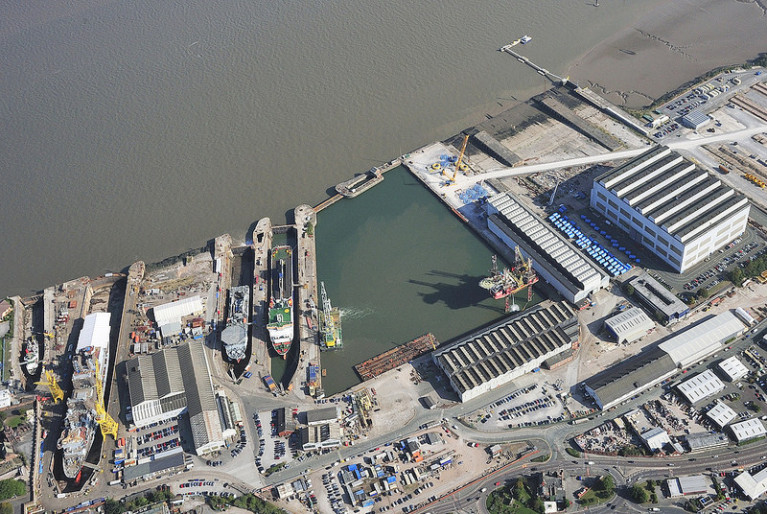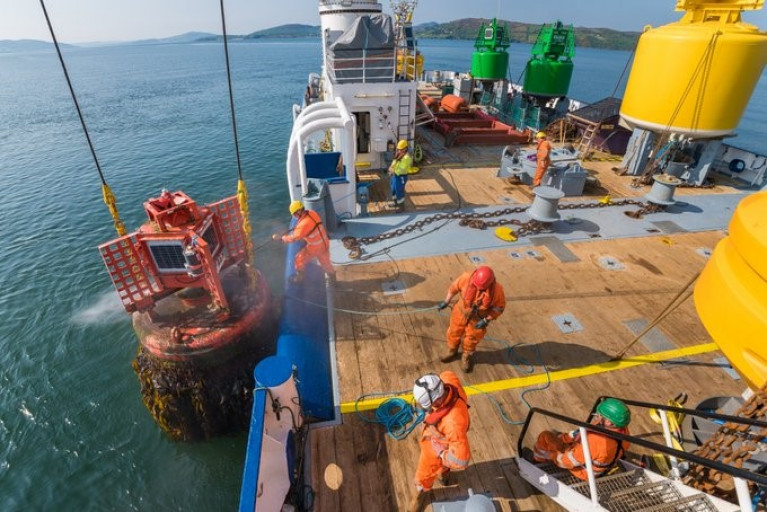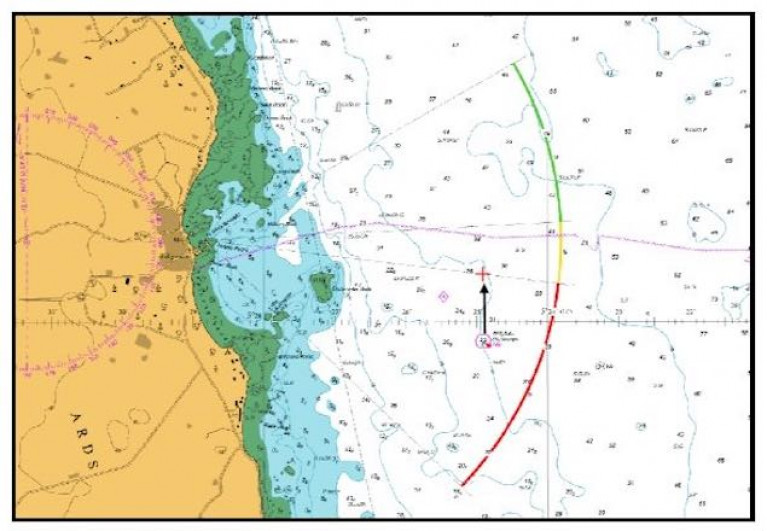Displaying items by tag: Irish Lights
Merseyside Shipyard Cammell Laird's Busy Commercial Division Enjoys End of Financial Year
Merseyside shipyard Cammell Laird continues to enjoy a busy 2022 with a range of commercial vessels visiting its facilities for extensive programmes of works.
In the same month that Prime Minister Boris Johnson and Defence Secretary Ben Wallace visited the Birkenhead based shipyard to unveil the new National Shipbuilding Strategy Refresh, Cammell Laird completed several dry dockings and ship repair projects.
Ro-Ro passenger ship MV Hebrides departed no. 6 drydock on Wednesday, March 21 following an extensive overhaul and repair programme, which included the replacement of its sewage treatment plant, and the replacement of its fast rescue boat davits. The vessel is operated by CalMac and connects the Scottish isles of Skye and Harris.
The Stena Adventurer, a Ro-Pax ship owned by Stena Line, has returned to Cammell Laird for a large package of repair and overhaul works, which included the application of a new paint system. The ferry is one of two vessels, which operates on Stena Line’s Holyhead-Dublin route and makes two crossing per day. The ship has a maximum capacity of 1,500 passengers and 500 cars.
LM Constructor, a working barge, arrived in no. 5 drydock on Friday March 25th for five-year survey works. Built in the Netherlands in 1983, LM Constructor is a general-purpose vessel suitable for a wide range of inshore projects.
The Belgian tug Zeebrugge, is the latest vessel to depart Cammell Laird following a 16-day docking period for repair and overhaul works.
In January, Commissioners of Irish Lights vessel the ILV Granuaile docked at Cammell Laird. The multifunctional vessel, which services offshore buoys and is used for search and rescue missions, underwent general drydocking works for maintenance and repair including painting. (See CIL's Scottish counterpart vessel NLV Pharos at H&W Belfast).
Another tug, Svitzer Milgarth also docked in January for general drydock works including port and starboard aquamaster shaft seal removal, and general inspections.
The third CalMac vessel of the season, MV Clansman arrived in no.6 drydock in January also, for an extensive programme of overhaul and repair works including the removal and replacement of the sewage treatment plant and tail shaft works.
Mike Hill, Managing Director at Cammell Laird said: “It has been fantastic to see all of our ship repair facilities being used during this busy period".
“The recent works we have carried out highlights the demand of Cammell Laird and its highly skilled workforce. We look forward to welcoming our returning and new customers to the facility over the coming months.”
Irish Lights is recruiting for an Engineering Operations Manager (Chief Engineer) for a challenging and rewarding management role on board their multi-purpose DP 1 vessel, Granuaile.
THE SHIP
ILV Granuaile is a multifunctional vessel that primarily operates in the waters around the coast of the Island of Ireland. Its primary function is to place and service offshore buoys, which warn mariners of the location of sandbanks, reefs and other offshore hazards near shipping routes. The vessel also serves as a helicopter platform for servicing offshore lighthouses and is available to assist State agencies with search and rescue, emergency towing, oil pollution control, surveying and offshore data collection.
THE ROLE
In addition to the normal duties of a Chief Engineer, the successful candidate is required to fulfil a proactive management role with responsibilities for the ships technical superintendence, refit/drydock planning, and Class survey as well as work associated with Aids to Navigation support and charter work.
THE REQUIREMENTS
Candidates should have experience in Continuous Survey certification and hold a Chief Engineer STCW A-III/2 Unlimited Certificate. Previous experience in the role of Chief Engineer on similar vessels is essential in addition to the essential criteria listed in the Candidate Briefing Pack.
This role will require a person who is confident, articulate and self-motivated. They need to be a problem solver with solid leadership qualities and keen to take responsibility.
They will also have strong collaborative and flexible attributes that reflect the particular requirements of this senior role. Due to the nature of the propulsion, navigation and management systems on board the ship, candidates will be expected to be proficient in dealing with electronic and power management systems.
An attractive salary, time on time off roster and pension scheme is available. Please visit our website to view the Candidate Briefing Pack for further information on the role and requirements here
The closing date for applications is Friday, 8 April 2022. Please apply by emailing a CV and cover letter to Gemma Gregan at [email protected].
Please view the Irish Lights Job Applicant Privacy Notice on the company website.
Met Éireann & Irish Lights Collaborate to Improve Safety for Coastal Inhabitants & Mariners
Met Éireann and Irish Lights are pleased to announce a joint collaboration that will enhance our understanding of Irish Coastal Waters, with the aim of improving safety for coastal inhabitants and mariners.
Safety of the mariner and the public has been at the heart of Irish Lights and Met Éireann since their establishment over 235 and 85 years ago respectively. The seas around the island of Ireland are changing due to the impact of climate change and both organisations are adapting by developing new additional services. In line with the government’s Climate Action Plan and The Status of Ireland’s Climate Report 2020, a better understanding of our adjacent seas is needed including the wave conditions around the Irish coast.
Launching on 1st February, St. Brigid’s Day, the Patron Saint of Sailors, the trial will involve adapting existing navigation buoys operated by Irish Lights with new wave sensors, providing quality controlled near real-time meteorological and hydrographic data for the benefit of stakeholders in coastal areas.
 Map of Wave Buoy Deployment and Irish Lights Buoy Network
Map of Wave Buoy Deployment and Irish Lights Buoy Network
Ronan Boyle, Director of eNavigation & Maritime Services for Irish Lights, said: “Irish Lights is delighted to support this trial with Met Éireann, which is closely aligned with our Vision of protecting lives, property, trade and the environment by delivering next generation maritime services. We look forward to a successful completion of the trial period and a possible future expansion of this monitoring network for the safety of all”.
The data from Irish Lights navigation buoys will be used by Met Éireann’s Flood Forecasting Division to develop coastal predictive modelling systems for tidal, storm surge and wave forecasting for Ireland. The acquisition of near-real-time data will prove beneficial to the Flood Forecasting Division before, during and after coastal flood events. This meteorological and hydrographic information provided by Irish Lights will support stakeholders to make impact-based decisions and take actions that protect against the loss of life and to mitigate against damage to property and the environment.
Rosemarie Lawlor, Hydrometeorologist at Met Éireann said: “This important capacity-building collaboration is an exciting first step in building on our understanding of Irish seas and coasts and continues the essential work of improving safety of our coastal and marine areas”
The four Irish Lights navigation buoys which are part of the trial are Ballybunnion buoy (Shannon Estuary)*, Finnis buoy (Galway Bay), South Hunter buoy (Larne) and Splaugh buoy (Rosslare)
The project is divided into three stages:
- Procurement & Testing,
- Deployment, and
- Trial.
As part of stage one Met Éireann procured and provided Irish Lights with wave sensors, data loggers and modems for their navigation buoys. A new quality control process has been developed by Met Éireann in collaboration with Irish Lights and the Marine Institute for testing the data in stage three. Irish Lights have installed, tested and commissioned the sensors on each buoy over recent months to enable the transmission of the data.
 Splaugh Buoy on Irish Lights ship ILV Granuaile, ready for installation of new wave sensor
Splaugh Buoy on Irish Lights ship ILV Granuaile, ready for installation of new wave sensor
In stage two the equipment was deployed by Irish Lights and we are currently entering stage three, the trial, with data transmission from the buoys initiated. The new sensors are measuring wave height, wave period and wave direction. The data will be tested, verified and quality controlled to ensure it is fit for purpose as part of stage three.
At present this data is openly available in near real-time at the following websites:
Met Éireann - https://www.met.ie/forecasts/marine-inland-lakes/buoys
Irish Lights - https://cilpublic.cil.ie/metocean/
The near real-time wave data will provide current wave conditions at the deployment locations to end-users.
Irish Lights Recruiting for Coastal Operations & Property Manager
Are you up for the challenge of managing the network of lighthouses around the coast of Ireland? If so, the Commissioners of Irish Lights want to hear from you.
The agency is now recruiting for the role of Coastal Operations and Property Manager, who will be responsible for making sure Ireland’s 65 lighthouses — plus 141 buoys and 22 beacons — are safe to access and use, and maintained and powered sustainably into the future.
Some of Ireland’s lighthouse stations are over 200 years old, and are found in exceptionally beautiful and challenging locations.
But with new communication and navigation equipment as well as powerful LED lights, they continue to provide a vital service to mariners and increasingly also to local tourism, heritage and environmental protection programmes.
As Coastal Operations and Property Manager, the successful candidate will lead and develop a strategic approach to Irish Lights property and aids to navigation (AtoN) asset management.
Among their many responsibilities, they will manage a team of over 20 employees, including managers, team leads, technicians and general workers; obtain relevant planning and environmental consents for capital and maintenance works; fostering strong stakeholder relationships; and oversee capital projects’ timelines and budgets.
The successful candidate will have at least 10 years’ relevant engineering experience, with at least seven in a team and organisational leadership role.
Previous experience working in a marine environment or with coastal assets, ideally in a civil engineering capacity, is also expected, as are strong people management skills, with the ability to foster collaboration and a cohesive team environment.
Irish Lights offers the opportunity to manage a dynamic and vital operation, as well as leading the coastal operations team into the future. The role also comes with a strong remuneration package as well as a highly competitive pension scheme.
A full candidate briefing pack is available on the Irish Light website. To learn more about this job, email [email protected] or call Jasper Wiley on +353 1 474 4623 and see the job spec page on the Sigmar Recruitment website.
The closing date for applications is 5pm on Friday 14 January 2022.
Vacancy for a Navigation Advisory Services Officer (Shore-based) - Specified Purpose Contract
Irish Lights is currently recruiting a Navigation Advisory Services Officer on a specified purpose contract for a minimum duration of 8 months. This is an exciting opportunity for an experienced mariner with sea-going and/or shore-based experience. The role will report to the Navigation Services Manager and will work closely with the Local Aids to Navigation Lead and other members of the eNavigation and Maritime Services Team.
This specified purpose contract would be an ideal opportunity to allow the successful candidate gain an insight into the operation of a modern General Lighthouse Authority, tasked with the provision, superintendence and management of aids to navigation for the safety of all sectors and maritime users. The successful candidate will develop their existing experience in stakeholder management, customer support, navigation risk assessments and commercial contracts and have the opportunity to build upon their professional network in wider industries.
THE ROLE
The Navigation Advisory Services Officer will assist Irish Lights to meet the requirements of our strategy "Safe Seas – Connected Coasts". The role will focus on the superintendence and management of the 3,600 Local Aids to Navigation (AtoN) and 56 Local Lighthouse Authorities around the Island of Ireland. This typically involves being on the coast inspecting for one week, with the following week spent completing the reports and statutory office-based work. While on the coast, the role is also asked to identify possible commercial and value-added opportunities for Irish Lights.
THE PERSON
The ideal candidate will have excellent people skills and an ability to establish and build relationships across multiple agencies and community organisations. They will also have regulatory and business development skillsets and a proven business sales ability and growth mindset.
QUALIFICATIONS
Applicants must be Officer of the Watch (Deck) STCW 95 or fishing or naval equivalent qualified. A degree-level qualification in a relevant field is desirable.
Please visit our website to view the Candidate Briefing Pack for further information on the role and the requirements - https://irishlights.ie/who-we-are/vacancies/navigation-advisory-services-officer.aspx
The closing date for applications is Friday, 12 November 2021. Please apply by sending a CV and cover letter to Gemma Gregan at [email protected]. Please view Irish Lights Job Applicant Privacy Notice on the Vacancies page.
Irish Lights Recruiting for Navigation Advisory Services Officer
Irish Lights is currently recruiting for a Navigation Advisory Services Officer on a specified purpose contract for a minimum duration of eight months.
It’s described as “an exciting opportunity for an experienced mariner with commercial sea-going and/or shore-based experience”.
The successful candidate will assist Irish Lights to meet some of the additional requirements identified in its strategy Safe Seas – Connected Coasts.
The role requires a mix of regulatory and business development skillsets. Previous experience in defining and developing new services for commercial clients would be an advantage.
This varied, shore-based role will involve a mix of office-based work in Dun Laoghaire and a significant amount of time on the coast.
Applicants must be Officer of the Watch (Deck) STCW 95 or fishing- or naval-equivalent qualified. A degree level qualification in a relevant field is desirable.
For more on the role, including a link to the Candidate Briefing Pack, see the Irish Lights website HERE. (The job applicant privacy notice can be found HERE.)
The closing date for applications is Friday 12 November. Please apply by sending a CV and cover letter to Gemma Gregan at [email protected].
The latest Marine Notice from the Department of Transport gives advance notice of the discontinuation of the Differential Global Positioning System (DGPS) service around the coast of the island of Ireland from 31 March 2022.
DGPS has been provided as an augmentation service of the GPS signal by the General Lighthouse Authorities in Ireland and the UK since 1997.
The Commissioners of Irish Lights, in consultation with the Department of Transport, have resolved that the DGPS service has now become redundant and has decided to discontinue the service in waters around the coast of the island of Ireland after 31 March 2022.
Further information and guidance for maritime users is available on the Irish Lights website. This explains the background, consultation with the wider DGPS user group and guidance for maintaining the safety of navigation after the DGPS service ceases next spring.
Today is World Marine Aids to Navigation Day
IALA hosts the World Marine Aids to Navigation Day (WATON) which for this year will also be celebrated virtually, writes Jehan Ashmore.
The International Association of Marine Aids to Navigation and Lighthouse Authorities (IALA) is a non-profit, international technical association established in 1957.
Among the role of IALA is to gather together Marine Aids to Navigation authorities, manufacturers, consultants, and, scientific and training institutes from all parts of the world and offers them the opportunity to exchange and compare their experiences and achievements.
In Ireland the event is recognised by the Commissioners of Irish Lights based in Dun Laoghaire Harbour where also today at their headquarters, the Taoiseach launched the National Marine Planning Framework and Maritime Area Planning Bill.
Irish Lights is responsible for waters north and south and is among three General Lighthouse Authorities (GLA's) also involved in Aids to Navigation (AtoN) around the coast of Britain.
The other GLA's in which Irish Lights works in close co-operation and mutual support is Trinity House (England & Wales) and the Northern Lighthouse Board (Scotland and Isle of Man).
Everyone is invited to take part this WATON by sharing photos of AtoN's on Social Media so to raise awareness world-wide.
Irish Lights carry out a constant maintenance and monitoring service for its buoy fleet around the coast from its headquarters at Dun Laoghaire Harbour.
Buoys are prepared to the International Association of Marine Aids to Navigation and Lighthouse Authorities (IALA) standards in its state-of-the-art buoy service facility.
The ILV Granuaile ship is used for maintenance/replacement programmes and as our photo above shows the eight-metre Irish Lights timber workboat is capable of towing big buoys too!
Irish Lights, which have been based at Dun Laoghaire Harbour since the late 1800s, is a maritime organisation delivering an essential safety service around the coast of Ireland, protecting the marine environment, and supporting the marine industry and coastal communities. In recent years Irish Lights has transformed how it delivers its services, exploiting new technology and new opportunities.
Repositioning of the Skulmartin Buoy off North County Down Coast
The Commissioners of Irish Lights has, in the Notice to Mariners 05/2020, given notice that on 30th October or as soon as circumstances permitted, the existing Skulmartin Buoy off the north County Down coast, is to be repositioned.
The existing position is Lat 54deg 31.848' N - Long 005deg 24.910' W and the new position is Lat 54° 32.393'N Long 005° 24.910'W.
The dangerous Skulmartin Rocks off the village of Ballywalter were marked by a 'bell boat' in the late 1870s which was replaced by the manned Skulmartin Light vessel in 1886.
 The manned Skulmartin Light vessel of 1886
The manned Skulmartin Light vessel of 1886
This, in turn, was replaced by a lit whistle buoy in June 1967 and on 6th December 2004, the wave activated whistle fog signal was permanently discontinued.
































































